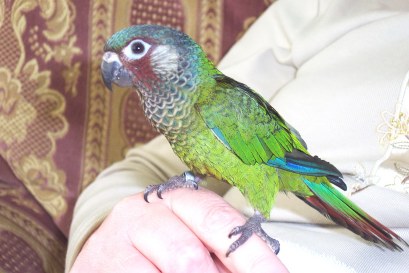Conure - Painted
Scientific Name: Pyrrhura picta picta
Sat, 12th July, 2025 - 4:30 am GMT
Sponsor Ads:

Alternative Name
Scientific Name: Pyrrhura picta pictaBasic Info
The Painted Conure has green plumage and a long tail. There is a thin band above the bill that is dark red, almost brown. The forehead and front of the crown is blue. The back of the head and nape is dark brown with a blue band going to the nape. The periopthalmic ring is dark gray and the irises are brown. The feathers on the upper breast of the Painted Conure are edged in white. The sides of the throat and neck go from gray-brown to green, as does the upper half of the breast. The upper tail coverts are a dark red and part of the wing is red. Parts of the primary feathers of the beautiful Painted Conure are blue. The top of the tail is green with some dark red and the underside is duller. The feet and bill are gray. The young ones are duller in color and very little red on the wing.
Health
As with most parrots, always offer Painted Conures fresh fruits and vegetables, as well as foods such as beans and cooked eggs. Water should be changed daily, and it is equally important to remove fresh food quickly so it does not spoil. The Painted Conure only needs a vitamin supplement if on a strictly seed diet. The size of the cage should be sufficient to accommodate their wings and to give them room to play. Usually, a 24-inch by 24-inch by 36-inch cage will do. Larger cages also work well, but it is important that the space between the bars is not more than 3/4 of an inch wide so they do not get stuck. A variety of perches should be provided to give their feet exercise. Feeding dishes should not be placed directly below perches. If they are placed directly below a perch food and water will get spoiled. Toys are necessary, since Conures are avid chewers. In addition they should be provided with a dish for bathing and if this is not possible they should be sprayed with water regularly. Conures are prone to a vitamin K deficiency and a bleeding disorder, but with the proper nutrition, both of these can be avoided. Conures are also good flyers, and require more clipping, but never too much, so the bird will fly gently to the floor. Breeding Painted Conures are not easy to breed, and they are not recommended for first time breeders. The average clutch is anywhere from 4 to 9 eggs. The incubation period lasts for about 23 days. The chicks will leave the nest around 5 weeks, but the parents will still feed them for a few more weeks. The nest box should be approximately 17-inches X 12-inches X 9-inches with a 3-inch entrance hole. The Painted Conure loves to sleep in the nest box, so it is always good to keep one in the cage all the time.Habitat
N/ABehavior
Painted Conures are sweet natured as well as being beautiful in their coloring. Though not as easy to find, if you are lucky enough to find one, the Painted Conure will make a wonderful addition to many homes and aviaries. The Painted Conure is a smaller parrot, from 8.5 to 9 inches in length, but that does not make them in anyway inferior. They have large personalities and lots of energy. The Painted Conure loves to play, and is very curious. It is always good to let your Conure have time outside of the cage, whenever possible and they can be very entertaining. Some Painted Conures talk a little, and many can be trained to do simple tricks. One very good feature of the Painted Conure is that they are less noisy then some of the other Conure parrots. Because of this trait, the Painted Conure is the one to choose if you live in an apartment.Origin
VenezuelaHistory
The Painted Conure comes from South America, including parts of Venezuela, Brazil, French Guiana and Surinam. They are not easily bred, so their demand is high. Their numbers in the United States are low and Painted Conures are mostly bred for breeding purposes.Common Foods
N/ASponsor Ads:
"The eternal mystery of the world is its comprehensibility." -- Albert Einstein
Conure - Painted
Coded by: BGID® | ALL RIGHTS RESERVED Copyright © 2000-2025
Disclaimer | Privacy | Report Errors / Contact | Credits










